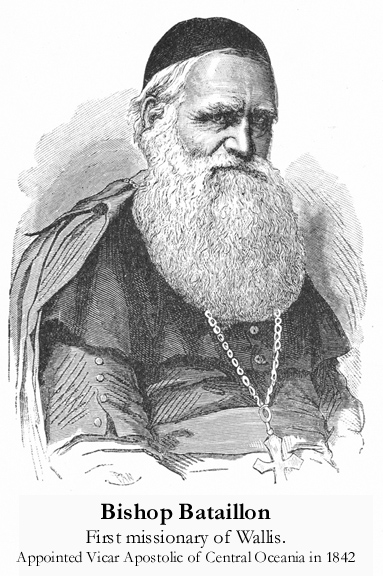APAC111
From Marist Studies
Bataillon on Futuna
- Bataillon wrote later that he gave Chanel a hand in rebuilding his house. Chanel’s own account suggests that the visit of the Reine de Paix, as well as the presence of Bataillon, moved Niuliki into action He made his people cut posts in the bush, sew leaves for the roof, carry sand from the beach for the floor and he did everything in his power to get the job done, in fact he joined in the work himself. The missionaries too worked with the people and kept their interest alive by donating a few pigs.[1]
- The two also worked on the language together, translated catechetical texts, prayers and hymns from Wallisian into Futunan and even composed a hymn to Our Lady, straight in Futunan.[2] They visited all the hamlets on the island and crossed over to Alofi. Bataillon found the Futunans more open, simpler, less prejudiced against Europeans.[3] He was convinced that, were it not because of the endemic warfare between Tua and Singave, Futuna would already have been converted.
- Bataillon challenged Niuliki to bring in all the atua muri that hung here and there on trees and on particular places. He would burn the lot![4] Niuliki and the chiefs laughed at him, sure he would be too afraid of the misfortune that the spirits would bring down on him. Next day the two missionaries went on a tour of the island and burnt most of the atua muri they found,[5] with the villagers looking on in fear from a safe distance. The next morning they were surprised to see the missionaries walking round unscathed.[6] At least, that is Bataillon’s story.[7] A few days later he questioned Niuliki on his ancestral god Taga roa until he reduced the king to silence.[8]
- Chanel’s meticulous day-to-day account confirms that on 1 June Bataillon challenged Niuliki to bring all the atua muri to be burnt and that on 5 June they did in fact burn one atua muri of the notorious trouble maker Vae Tosso. He does not mention anything more.[9] Whatever happened, Chanel’s short, sober and casual mention strongly suggests that he was not all that happy with the confrontational tactics of his confrere. He had never done such a thing.[10] Chanel took a more tolerant view of the traditional religion as is clear from the fact that a few days later, when the prophetess Faremaa uttered an oracle of the god Taga roa in the presence of the two missionaries, Chanel presented her with a nice dress for one of her daughters.[11]
- Chanel tried to talk Bataillon into staying longer, but he could not leave Brother Joseph Luzy alone on Wallis. When the weather improved and Jones decided to sail to Wallis, he took the opportunity and left, 3 July 1839. He had spent fifty-six days on Futuna.[12]
- The return trip turned into an adventure. There were more Wallisians than Jones’ little schooner could carry and they did not want to leave the canoe behind on which some of them had come. They decided to travel by their own craft, promising to stay close to the schooner. However, the canoe was much faster than the ship and during the night they got far ahead, heading too far south, in the direction of Samoa. In the morning the canoe could only just be seen from the masthead and Bataillon urged Jones to go after them. When the men in the canoe saw the ship following them, they misunderstood its intention and paddled even harder: further into the wrong direction! Then the weather closed in and Bataillon tried to get Jones to go searching for them, but Jones judged he had to abandon the pursuit and turn to Wallis. It was a rough night and Bataillon feared for the lives of the people in the canoe: ‘if only they had been baptised and in the state of grace!’. Bataillon had to tell the king that the men he had promised to return to Wallis were lost at sea. The Lavelua was upset, but he also had more confidence in their seamanship. In the end he did not blame Bataillon but his own men for their recklessness. As it turned out, they got to an island in the Fiji group and returned many months later to Wallis.[13]
Notes
- ↑ EC, pp. 435ff, 25.10.ff
- ↑ LRO, doc. 38 [4].
- ↑ Unlike Futuna, Wallis has a safe anchorage: an attractive place for whalers and other ships. At Futuna ships would call, but they seldom stayed for any length of time.
- ↑ The atua muri were a sort of amulets, cf. footnote nr. 4 at LRO, doc. 38 [4].
- ↑ la plus grande partie des de ces indices redoutables de leurs divinités
- ↑ LRO, doc. 38 [4].
- ↑ Ronzon, Delorme, p. 67. quotes an unidentified account that largely supports Bataillon. It could be a later paraphrase of Bataillon’s own tale.
- ↑ CE, p. 439, 10.06.1839.
- ↑ Cf. EC, p. 411-412, 08.02; 11.02; 13.02.
- ↑ Bataillon says it was the first time this was done. That would be true. But, not unlikely, Bataillon exaggerated and dramatized his own role in the proceedings!
- ↑ EC, p. 439, 11.05. Cf. Excursus C, On Power Encounter and Iconoclasm, below, pp. 116ff
- ↑ EC, p. 443, 03.07
- ↑ LRO, doc. 38 [5]. Cf. Chanel’s later hearsay version, EC, doc. 56 [3].
| Previous Section | A Piety Able to Cope | Next Section |
